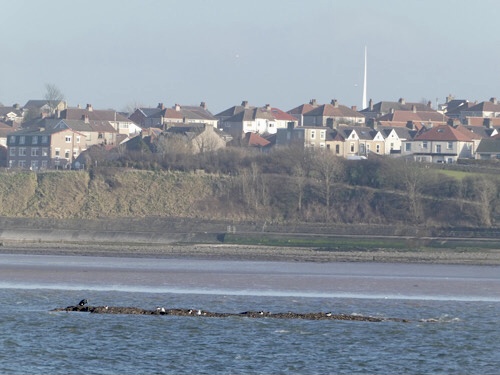The wind was quite fresh starting more or less due south then working round to SW. Mainly sunny, but an odd light shower.
Howard manage to read four ringed Knot from c2,000 birds roosting in the old heliport area at high water. These two from different ringing schemes, photographed on the Near Naze rocks.
 |
| Ringed at Ainsdale Merseyside |
 |
| A bird from a Dutch ringing scheme |
Ringed
I imagine patches of lush green like this along the shore indicates the presence of both food and fresh water. In this instance they only wanted a drink. They landed in the freshwater run off, began drinking, then 10 minutes later flew off again high to the north. This clip shows them landing in the freshwater run off. Unfortunately I stopped filming before they began drinking.Pale-bellied Brent geese 62 - as I walked along the sea wall, the birds started arriving to feed on the gutweed. Three flocks 39, 4 and 19. Perhaps the 4 were the earlier birds returning. Later there were a total of 49 on and around the skear.
Rock Pipits 6
10 goldfinch (obviously moving through at moment)
4 greenfinch and a robin
Flock 16 jackdaw plus loose flock 10 c crow north east together.
Two Siskin heard.
Pete also manager a short sea watch:
Shoveler 1 drake in
Red-breasted Merganser 2 out
Kevin Singleton also managed a quick visit
 |
| Knot |
 |
| Magpies seldom get a mention, but they are a handsome bird I tried, and failed, to work out what it has been eating to have its bill stained like this. |
South shore (MD)
I went past Red Nab long before the tide reached it, and typically at this point in the tide it was deserted. I spotted a flock of 4 geese flying in to the bay. They turned out to be Pale-bellied Brent geese, but they appeared to be moving through, rather than just the regular local feeding movements. They were flying in, then they appear to spot Red Nab (now lush green) and turned to fly towards it. Unfortunately it took them nearly a minute so I've split the clip. This first clip shows them flying in, then veering off towards Red Nab.
On the way back most were feeding on the SW corner of Red Nab, they'll be off soon, so I took the opportunity to get a good group clip.
Wigeon c130 - there were c100 waiting in the channel next to No.2 outflow. This is typical of the regular feeding birds, which wait for the tide to reach Red Nab. But, as the Brents, long before the tide reached Red Nab a small flock flew in from the south, landed in the freshwater channel and began drinking. This time, I missed the flight in, but got them drinking. I left after this, so don't know if they stayed to feed.
Heysham skear low water 17:50
Brent geese 49
Eider 200+
Great Crested Grebe 8 (6 together plus a pair)
Red-breasted Merganser 3
Little Egret 3
The winter storms, coupled with a shift in direction of water flow out of the first channel has created a reef about 250m south of the normal skear edge, and a similar distance north of the green marker. It clearly wasn't fully exposed, but wave action suggest it is at least 200m long. This clip shows the location.
This area is typically just flat mud. A reef like this will only grow during the summer, and will make a significant difference to food supply here. It will concentrate detritus and the invertebrates that feed on on detritus, then fish that feed on the invertebrates. Ultimately, it must be a better area for diving birds to feed, and they don't take long to learn.
 |
| Part of the new reef exposed by this evening's 1.3m tide. Knowlys Road in the background |
No comments:
Post a Comment